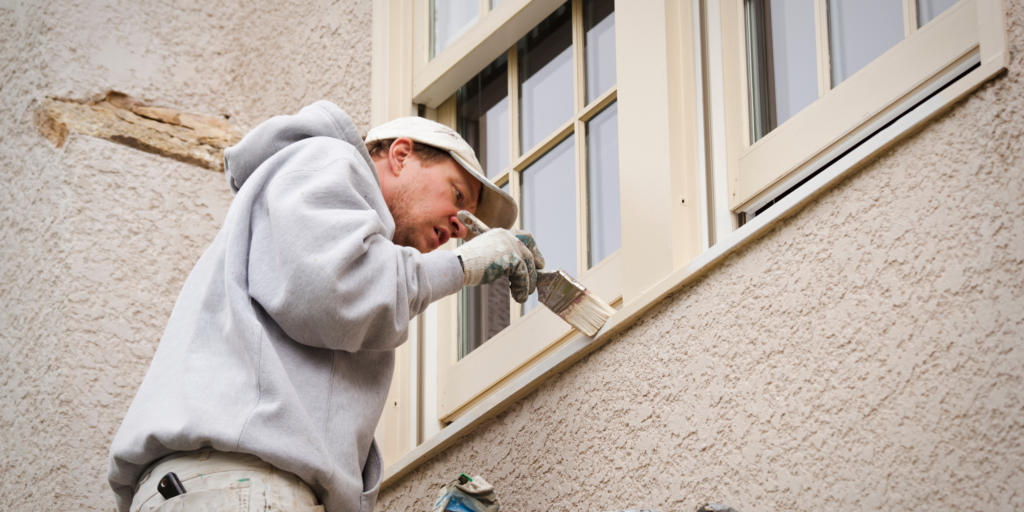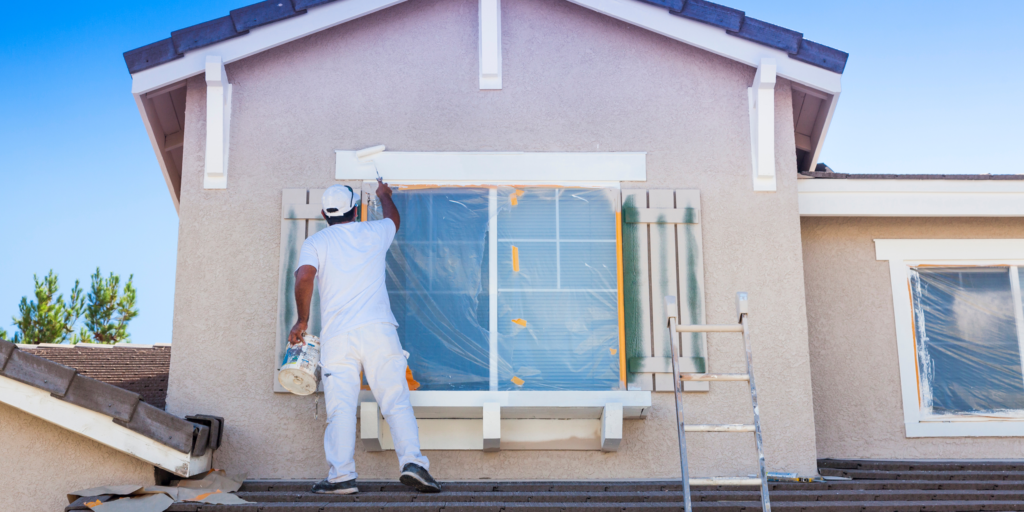Choosing the correct season to paint is vital if you want to update or transform your home’s exterior. A well-painted exterior adds curb appeal and weatherproofs your home.
When is the best time to start this project? It depends on weather, area climate, and preparedness. We’ll discuss all these factors and offer outdoor painting tips.
The importance of exterior house painting
Exterior house painting protects your home from the weather as well as beautifies it. Your home’s exterior is exposed to rain, snow, UV radiation, and temperature changes. These elements can cause peeling paint, rotting wood, and mold over time.
Regularly painting your home’s exterior protects it from these hazards. A fresh layer of paint prevents water damage to walls and siding. It also prevents bugs from entering through crevices.

Exterior painting keeps your home looking modern and well-maintained, increasing curb appeal. To sell your home or just enjoy living in a beautiful space, a professionally painted exterior can make all the difference.
Factors to consider before painting
There are several things to consider before painting your home’s exterior. These factors can considerably affect your paint job’s success and endurance.
Check your home’s exterior first. Are there cracks, peeling paint, or water damage? These difficulties must be addressed before painting. Repairing damage helps the fresh coat stick and remain longer.
Surface type is another consideration when painting. Different materials demand different paint and preparation methods. Wood siding may need sanding and priming before painting, while metal surfaces may need rust-prevention coatings.
Next, consider your climate. High temperatures and humidity can impair paint drying and adhesion. Rainy or hot weather is not ideal for painting.
Consider the time needed for exterior painting. It may take days or weeks, depending on your home’s size and detail. Make sure you have adequate time to do the job without rushing.
When painting, take safety precautions. You’ll need ladders, goggles, and gloves. Use drop cloths or masking tape to prevent splatters on plants, windows, and other surfaces.
You’ll set the stage for attractive, weather-resistant exterior home painting by carefully examining these things before starting!
The best weather conditions for painting
For an effective and long-lasting exterior paint job, choose the correct weather. Painting works well at moderate temperatures between 50 and 85 degrees Fahrenheit. This lets the paint cure without overheating or cooling.
Paint adhesion might be affected by humidity, so avoid painting on damp days. Avoid rainy or windy circumstances, which can smear, smudge, or damage freshly painted surfaces.
Planning your outside painting endeavor should also include the time of day. Direct sunlight can dry the paint too quickly, resulting in inconsistent effects. It’s ideal to operate in partial shade or around the sun’s location.
Before commencing a painting project, check local weather forecasts for rainstorms or dramatic temperature changes.
Choose the ideal weather for painting to achieve stunning, long-lasting results on your home’s exterior. So think ahead and choose wisely before painting!
Ideal seasons for painting in different regions
Painting the exterior of your home in the right season is essential for the best effects. Weather substantially affects paint drying and longevity. Here are some tips for choosing the best painting seasons in different places.
In northern North America and Europe, where winters are harsh, exterior painting should wait until spring or summer. The milder temperatures and extended daylight hours help the paint dry and adhere.
However, in hot and humid regions like the southern US or Southeast Asia, you may wish to avoid painting during summer. High humidity can blister or remove fresh paint. Choose early spring or fall for milder weather.
Timing is crucial in coastal and mountainous places with uncertain climates and frequent rainfall. Be patient until dry weather is predicted before commencing your project. Rain can smear or wash away freshly painted surfaces.
These recommendations are not fixed in stone; local climate trends should be considered while designing your painting schedule. Regionally experienced painters can offer important advice.
You may maximize short-term beauty and long-term protection for your home’s outside surfaces by carefully examining these aspects and picking an ideal season for outdoor painting work based on your region’s environment.
Tips for successful outdoor painting
There are several ways to paint the exterior of your home successfully. Preparation comes first. Before brushing, power wash or scrub the surface with soap and water.
Next, fix wall cracks and holes. Fill trim-siding gaps with caulk and spackle damaged areas. Remove paint chips and rough places with sanding.
Outdoor projects require proper paint selection. Choose premium exterior paints. These paints defend against harsh weather and endure long.
Instead of doing the whole house at once, work in small areas. This helps you focus on each area and improve coverage.
Remember safety! Put on goggles and gloves when painting or working with chemicals. Be careful when climbing ladders or working at heights.
Following these ideas will help you complete a good exterior painting project that will enrich your property for years!
How to prepare and protect your home for the painting process
Painting your home requires preparation to go smoothly. Proper preparation protects your property and yields long-term rewards.
Start by cleaning your home’s exterior. Power wash or hose out dust, filth, and cobwebs. Paint will stick better to a clean canvas.
Next, check surfaces for damage or degradation. Fill cracks and holes in walls, trim, and siding before painting. Fill gaps with caulk or putty and sand rough spots for a smooth finish.

To avoid drips and splatters, cover plants, furniture, and other outdoor things with drop cloths or plastic before painting. Remove any external decorations that could interfere, such as light fixtures or house numbers.
Painter’s tape around windows and doors prevents paint from getting on them. This ensures sharp lines after painting.
Use external brushes or rollers to apply paint. These tools are weatherproof and produce professional results.
Always paint eaves or overhangs first, then walls or siding, then windows or doors. It will provide even coverage.
Conclusion
The optimal time to paint your home’s exterior is vital for long-lasting and stunning effects. A good outdoor painting project requires consideration of weather, area climatic patterns, and planning.
Painting the exterior of your home requires timing. Knowing the best painting seasons can make all the difference, whether you live in a mild or hot climate.
Important takeaways:
1. Painting is best at 50–85°F (10–29°C), 40–70% humidity, and dry circumstances.
2. Spring and fall are ideal painting seasons due to mild temperatures and fewer harsh weather events.
3. If you live somewhere with hard winters or scorching summers, plan exterior painting tasks for warmer months or steady weather.
4. Clean and fix the surface before painting.
5. Guarding windows, doors, landscaping, and fixtures will prevent unintentional damage.
Every house has distinct locations and environmental conditions that affect its external surfaces’ lifetime. Professional painters or contractors in your area can offer specialized advice.
Don’t rush outside painting without thinking! Take advantage of good weather and adequate preparation for results that will keep your home looking fresh and lively for years!

